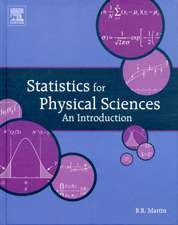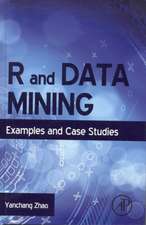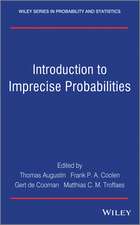Introduction to Probability Models
Autor Sheldon M. Rossen Limba Engleză Hardback – 4 mar 2014
| Toate formatele și edițiile | Preț | Express |
|---|---|---|
| Paperback (1) | 546.49 lei 5-7 săpt. | +78.66 lei 6-10 zile |
| ELSEVIER SCIENCE – 5 iul 2023 | 546.49 lei 5-7 săpt. | +78.66 lei 6-10 zile |
| Hardback (1) | 608.98 lei 6-8 săpt. | |
| ELSEVIER SCIENCE – 4 mar 2014 | 608.98 lei 6-8 săpt. |
Preț: 608.98 lei
Preț vechi: 790.88 lei
-23% Nou
116.54€ • 126.55$ • 97.90£
Carte tipărită la comandă
Livrare economică 23 aprilie-07 mai
Specificații
ISBN-10: 0124079482
Pagini: 784
Ilustrații: figures
Dimensiuni: 152 x 229 x 38 mm
Greutate: 1.13 kg
Ediția:11. Auflage.
Editura: ELSEVIER SCIENCE
Public țintă
Professionals and students in actuarial science, engineering, operations research, and other fields in applied probability.Cuprins
Recenzii
"…the newest edition updated with new examples and exercises, actuarial material, Hawkes and other point processes, Brownian motion, and expanded coverage of Markov chains. Although formally rigorous, the emphasis is on helping students to develop an intuitive sense for probabilistic thinking."--ProtoView.com, April 2014
Praise from Reviewers for the 10th edition:"I think Ross has done an admirable job of covering the breadth of applied probability. Ross writes fantastic problems which really force the students to think divergently...The examples, like the exercises are great." --Matt Carlton, California Polytechnic Institute"This is a fascinating introduction to applications from a variety of disciplines. Any curious student will love this book." --Jean LeMaire, University of Pennsylvania"This book may be a model in the organization of the education process. I would definitely rate this text to be the best probability models book at its level of difficulty...far more sophisticated and deliberate than its competitors." --Kris Ostaszewski, University of Illinois
Notă biografică
Sheldon M. Ross is a professor in the Department of Industrial Engineering and Operations Research at the University of Southern California. He received his Ph.D. in statistics at Stanford University in 1968. He has published many technical articles and textbooks in the areas of statistics and applied probability. Among his texts are A First Course in Probability, Introduction to Probability Models, Stochastic Processes, and Introductory Statistics. Professor Ross is the founding and continuing editor of the journal Probability in the Engineering and Informational Sciences. He is a Fellow of the Institute of Mathematical Statistics, and a recipient of the Humboldt US Senior Scientist Award.
Descriere
Suitable for a first undergraduate course in applied probability, this book introduces elementary probability theory and stochastic processes, and shows how probability theory can be applied fields such as engineering, computer science, management science, the physical and social sciences, and operations research.
















